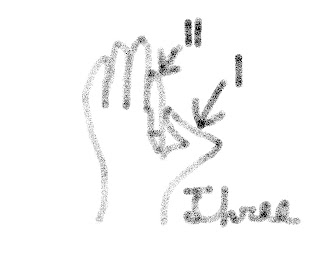It's really just ten plus one!
Wednesday, December 23, 2009
Friday, November 20, 2009
Ten

Stroke Notation: IIII IIII II
By the way, in order to avoid any misunderstandings from a middle finger being extended, I have learned to, instead of extending it, rest it over top of my thumb muscle. That way, it is still "out", whereas my index finger and ring finger (representing "two" and "eight" respectively) are neatly "tucked in" underneath my thumb muscle. I have also begun employing a colour scheme.
Monday, November 16, 2009
Youtube Video!
Binary Finger Counting from One to Thirty-One Youtube Video
I have been wanting to post a video like this for a very long time, and at last have been granted my desire!
Daniel
I have been wanting to post a video like this for a very long time, and at last have been granted my desire!
Daniel
Thursday, November 12, 2009
Eight
So, our thumb pulled in was one, our index finger pulled in was two, our middle finger pulled in was four, our ring finger pulled in was eight. Any guesses as to where all this is heading for our little finger?...
Monday, November 2, 2009
Seven
Stroke notation: IIII II I
Saturday, October 31, 2009
Friday, October 30, 2009
Five
Stroke notation: IIII I
(Any questions? Please feel free to ask... (although, I must admit, I've heard the one about "practical applications" quite a few times already, and can assure you that - in my experience - there have been no shortage of them))
Thursday, October 29, 2009
Tuesday, October 27, 2009
Three
That's right! 1 + 2 = 3. In our case, that's our index finger plus our thumb. Here it is in stroke notation:
II I
Two
So, in summary, we are giving our thumb a value of "one" when pulled in, and our index finger a value of "two" when pulled in. In stroke notation:
II
Any ideas how we would get "three"...? (Hint: _ + _ = 3...)
Wednesday, October 21, 2009
"One"
OK! Let's start counting... We pull in our thumb and call it: "One", like this:
In stroke notation:
I
Well, folks, that's all for tonight (or is that really early this morning!?) ;) I cannot wait to show you more, but I must go for now...
"Getting the Word Out"
I decided I would "hearken unto counsel" and keep getting the word out on Binary Finger Counting. What is it? It is, simply, doing more with less. The majority of us have five digits on each hand. What we do with them, however, in terms of counting is actually pretty simplistic. Basically, each digit is a assigned a value of "1", and then added together. So, for example, one extended finger (usually our index) respresents "One". Two extended fingers (such as our index and middle fingers) is considered to represent "Two", and etc. until all five digits are extended, which we typically consider to mean "Five".
This is, however, only scratching the surface of the potential we have. Let us start with our five digits all extended and, as a matter of fact, assume that to be "Zero" (!)
More later...
This is, however, only scratching the surface of the potential we have. Let us start with our five digits all extended and, as a matter of fact, assume that to be "Zero" (!)
More later...
Subscribe to:
Posts (Atom)










